Vlad I. Morariu
TextInVision: Text and Prompt Complexity Driven Visual Text Generation Benchmark
Mar 17, 2025Abstract:Generating images with embedded text is crucial for the automatic production of visual and multimodal documents, such as educational materials and advertisements. However, existing diffusion-based text-to-image models often struggle to accurately embed text within images, facing challenges in spelling accuracy, contextual relevance, and visual coherence. Evaluating the ability of such models to embed text within a generated image is complicated due to the lack of comprehensive benchmarks. In this work, we introduce TextInVision, a large-scale, text and prompt complexity driven benchmark designed to evaluate the ability of diffusion models to effectively integrate visual text into images. We crafted a diverse set of prompts and texts that consider various attributes and text characteristics. Additionally, we prepared an image dataset to test Variational Autoencoder (VAE) models across different character representations, highlighting that VAE architectures can also pose challenges in text generation within diffusion frameworks. Through extensive analysis of multiple models, we identify common errors and highlight issues such as spelling inaccuracies and contextual mismatches. By pinpointing the failure points across different prompts and texts, our research lays the foundation for future advancements in AI-generated multimodal content.
DocSynthv2: A Practical Autoregressive Modeling for Document Generation
Jun 12, 2024Abstract:While the generation of document layouts has been extensively explored, comprehensive document generation encompassing both layout and content presents a more complex challenge. This paper delves into this advanced domain, proposing a novel approach called DocSynthv2 through the development of a simple yet effective autoregressive structured model. Our model, distinct in its integration of both layout and textual cues, marks a step beyond existing layout-generation approaches. By focusing on the relationship between the structural elements and the textual content within documents, we aim to generate cohesive and contextually relevant documents without any reliance on visual components. Through experimental studies on our curated benchmark for the new task, we demonstrate the ability of our model combining layout and textual information in enhancing the generation quality and relevance of documents, opening new pathways for research in document creation and automated design. Our findings emphasize the effectiveness of autoregressive models in handling complex document generation tasks.
TutoAI: A Cross-domain Framework for AI-assisted Mixed-media Tutorial Creation on Physical Tasks
Mar 12, 2024Abstract:Mixed-media tutorials, which integrate videos, images, text, and diagrams to teach procedural skills, offer more browsable alternatives than timeline-based videos. However, manually creating such tutorials is tedious, and existing automated solutions are often restricted to a particular domain. While AI models hold promise, it is unclear how to effectively harness their powers, given the multi-modal data involved and the vast landscape of models. We present TutoAI, a cross-domain framework for AI-assisted mixed-media tutorial creation on physical tasks. First, we distill common tutorial components by surveying existing work; then, we present an approach to identify, assemble, and evaluate AI models for component extraction; finally, we propose guidelines for designing user interfaces (UI) that support tutorial creation based on AI-generated components. We show that TutoAI has achieved higher or similar quality compared to a baseline model in preliminary user studies.
MGDoc: Pre-training with Multi-granular Hierarchy for Document Image Understanding
Nov 27, 2022Abstract:Document images are a ubiquitous source of data where the text is organized in a complex hierarchical structure ranging from fine granularity (e.g., words), medium granularity (e.g., regions such as paragraphs or figures), to coarse granularity (e.g., the whole page). The spatial hierarchical relationships between content at different levels of granularity are crucial for document image understanding tasks. Existing methods learn features from either word-level or region-level but fail to consider both simultaneously. Word-level models are restricted by the fact that they originate from pure-text language models, which only encode the word-level context. In contrast, region-level models attempt to encode regions corresponding to paragraphs or text blocks into a single embedding, but they perform worse with additional word-level features. To deal with these issues, we propose MGDoc, a new multi-modal multi-granular pre-training framework that encodes page-level, region-level, and word-level information at the same time. MGDoc uses a unified text-visual encoder to obtain multi-modal features across different granularities, which makes it possible to project the multi-granular features into the same hyperspace. To model the region-word correlation, we design a cross-granular attention mechanism and specific pre-training tasks for our model to reinforce the model of learning the hierarchy between regions and words. Experiments demonstrate that our proposed model can learn better features that perform well across granularities and lead to improvements in downstream tasks.
Unified Pretraining Framework for Document Understanding
Apr 28, 2022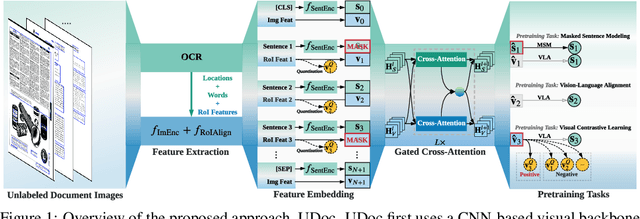
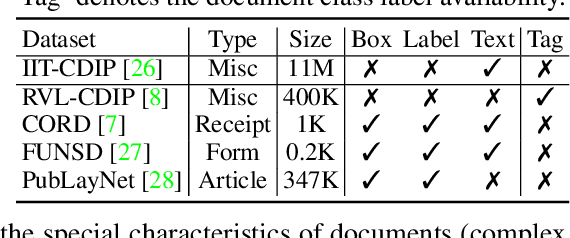
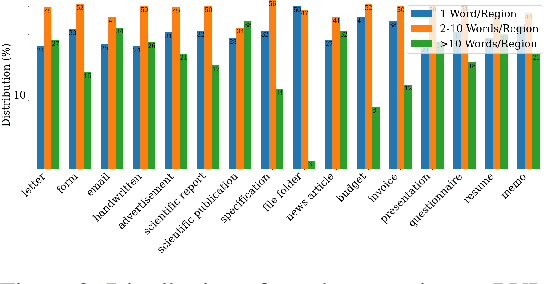

Abstract:Document intelligence automates the extraction of information from documents and supports many business applications. Recent self-supervised learning methods on large-scale unlabeled document datasets have opened up promising directions towards reducing annotation efforts by training models with self-supervised objectives. However, most of the existing document pretraining methods are still language-dominated. We present UDoc, a new unified pretraining framework for document understanding. UDoc is designed to support most document understanding tasks, extending the Transformer to take multimodal embeddings as input. Each input element is composed of words and visual features from a semantic region of the input document image. An important feature of UDoc is that it learns a generic representation by making use of three self-supervised losses, encouraging the representation to model sentences, learn similarities, and align modalities. Extensive empirical analysis demonstrates that the pretraining procedure learns better joint representations and leads to improvements in downstream tasks.
SelfDoc: Self-Supervised Document Representation Learning
Jun 07, 2021



Abstract:We propose SelfDoc, a task-agnostic pre-training framework for document image understanding. Because documents are multimodal and are intended for sequential reading, our framework exploits the positional, textual, and visual information of every semantically meaningful component in a document, and it models the contextualization between each block of content. Unlike existing document pre-training models, our model is coarse-grained instead of treating individual words as input, therefore avoiding an overly fine-grained with excessive contextualization. Beyond that, we introduce cross-modal learning in the model pre-training phase to fully leverage multimodal information from unlabeled documents. For downstream usage, we propose a novel modality-adaptive attention mechanism for multimodal feature fusion by adaptively emphasizing language and vision signals. Our framework benefits from self-supervised pre-training on documents without requiring annotations by a feature masking training strategy. It achieves superior performance on multiple downstream tasks with significantly fewer document images used in the pre-training stage compared to previous works.
RPCL: A Framework for Improving Cross-Domain Detection with Auxiliary Tasks
Apr 18, 2021
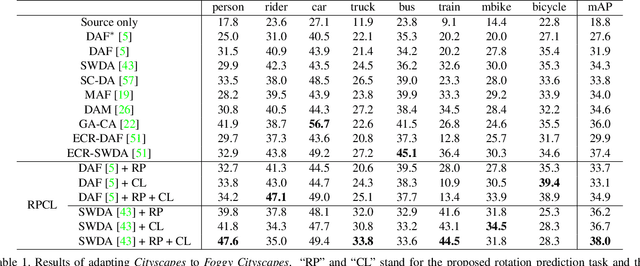


Abstract:Cross-Domain Detection (XDD) aims to train an object detector using labeled image from a source domain but have good performance in the target domain with only unlabeled images. Existing approaches achieve this either by aligning the feature maps or the region proposals from the two domains, or by transferring the style of source images to that of target image. Contrasted with prior work, this paper provides a complementary solution to align domains by learning the same auxiliary tasks in both domains simultaneously. These auxiliary tasks push image from both domains towards shared spaces, which bridges the domain gap. Specifically, this paper proposes Rotation Prediction and Consistency Learning (PRCL), a framework complementing existing XDD methods for domain alignment by leveraging the two auxiliary tasks. The first one encourages the model to extract region proposals from foreground regions by rotating an image and predicting the rotation angle from the extracted region proposals. The second task encourages the model to be robust to changes in the image space by optimizing the model to make consistent class predictions for region proposals regardless of image perturbations. Experiments show the detection performance can be consistently and significantly enhanced by applying the two proposed tasks to existing XDD methods.
Black-box Explanation of Object Detectors via Saliency Maps
Jun 05, 2020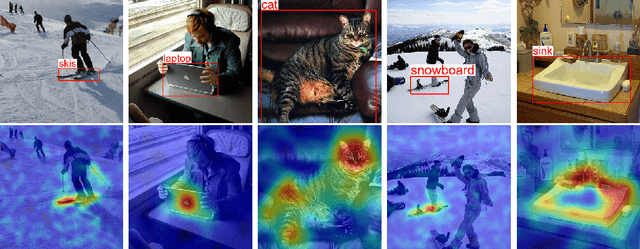
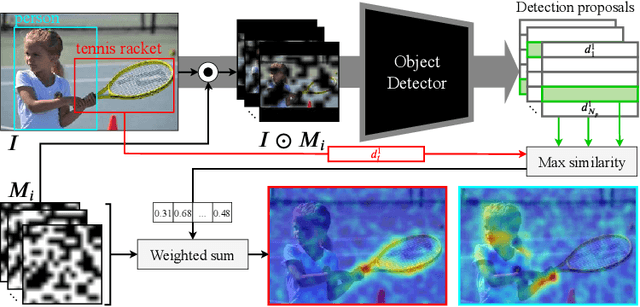
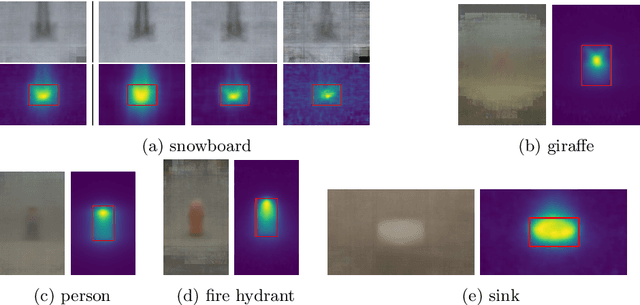
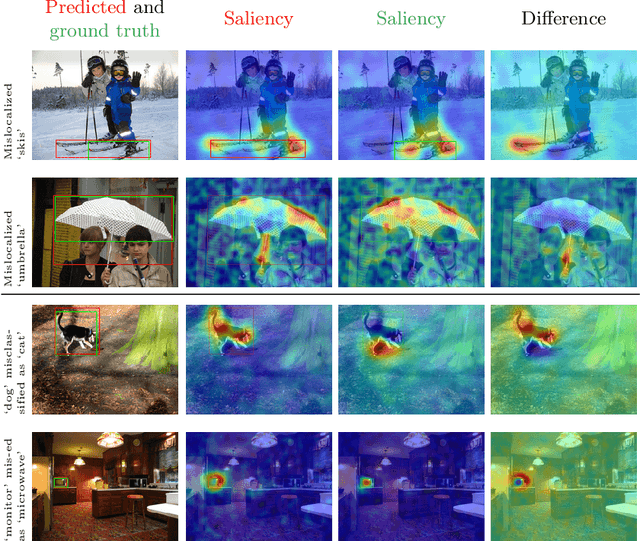
Abstract:We propose D-RISE, a method for generating visual explanations for the predictions of object detectors. D-RISE can be considered "black-box" in the software testing sense, it only needs access to the inputs and outputs of an object detector. Compared to gradient-based methods, D-RISE is more general and agnostic to the particular type of object detector being tested as it does not need to know about the inner workings of the model. We show that D-RISE can be easily applied to different object detectors including one-stage detectors such as YOLOv3 and two-stage detectors such as Faster-RCNN. We present a detailed analysis of the generated visual explanations to highlight the utilization of context and the possible biases learned by object detectors.
Cross-Domain Document Object Detection: Benchmark Suite and Method
Mar 30, 2020



Abstract:Decomposing images of document pages into high-level semantic regions (e.g., figures, tables, paragraphs), document object detection (DOD) is fundamental for downstream tasks like intelligent document editing and understanding. DOD remains a challenging problem as document objects vary significantly in layout, size, aspect ratio, texture, etc. An additional challenge arises in practice because large labeled training datasets are only available for domains that differ from the target domain. We investigate cross-domain DOD, where the goal is to learn a detector for the target domain using labeled data from the source domain and only unlabeled data from the target domain. Documents from the two domains may vary significantly in layout, language, and genre. We establish a benchmark suite consisting of different types of PDF document datasets that can be utilized for cross-domain DOD model training and evaluation. For each dataset, we provide the page images, bounding box annotations, PDF files, and the rendering layers extracted from the PDF files. Moreover, we propose a novel cross-domain DOD model which builds upon the standard detection model and addresses domain shifts by incorporating three novel alignment modules: Feature Pyramid Alignment (FPA) module, Region Alignment (RA) module and Rendering Layer alignment (RLA) module. Extensive experiments on the benchmark suite substantiate the efficacy of the three proposed modules and the proposed method significantly outperforms the baseline methods. The project page is at \url{https://github.com/kailigo/cddod}.
Referring to Objects in Videos using Spatio-Temporal Identifying Descriptions
Apr 08, 2019



Abstract:This paper presents a new task, the grounding of spatio-temporal identifying descriptions in videos. Previous work suggests potential bias in existing datasets and emphasizes the need for a new data creation schema to better model linguistic structure. We introduce a new data collection scheme based on grammatical constraints for surface realization to enable us to investigate the problem of grounding spatio-temporal identifying descriptions in videos. We then propose a two-stream modular attention network that learns and grounds spatio-temporal identifying descriptions based on appearance and motion. We show that motion modules help to ground motion-related words and also help to learn in appearance modules because modular neural networks resolve task interference between modules. Finally, we propose a future challenge and a need for a robust system arising from replacing ground truth visual annotations with automatic video object detector and temporal event localization.
 Add to Chrome
Add to Chrome Add to Firefox
Add to Firefox Add to Edge
Add to Edge